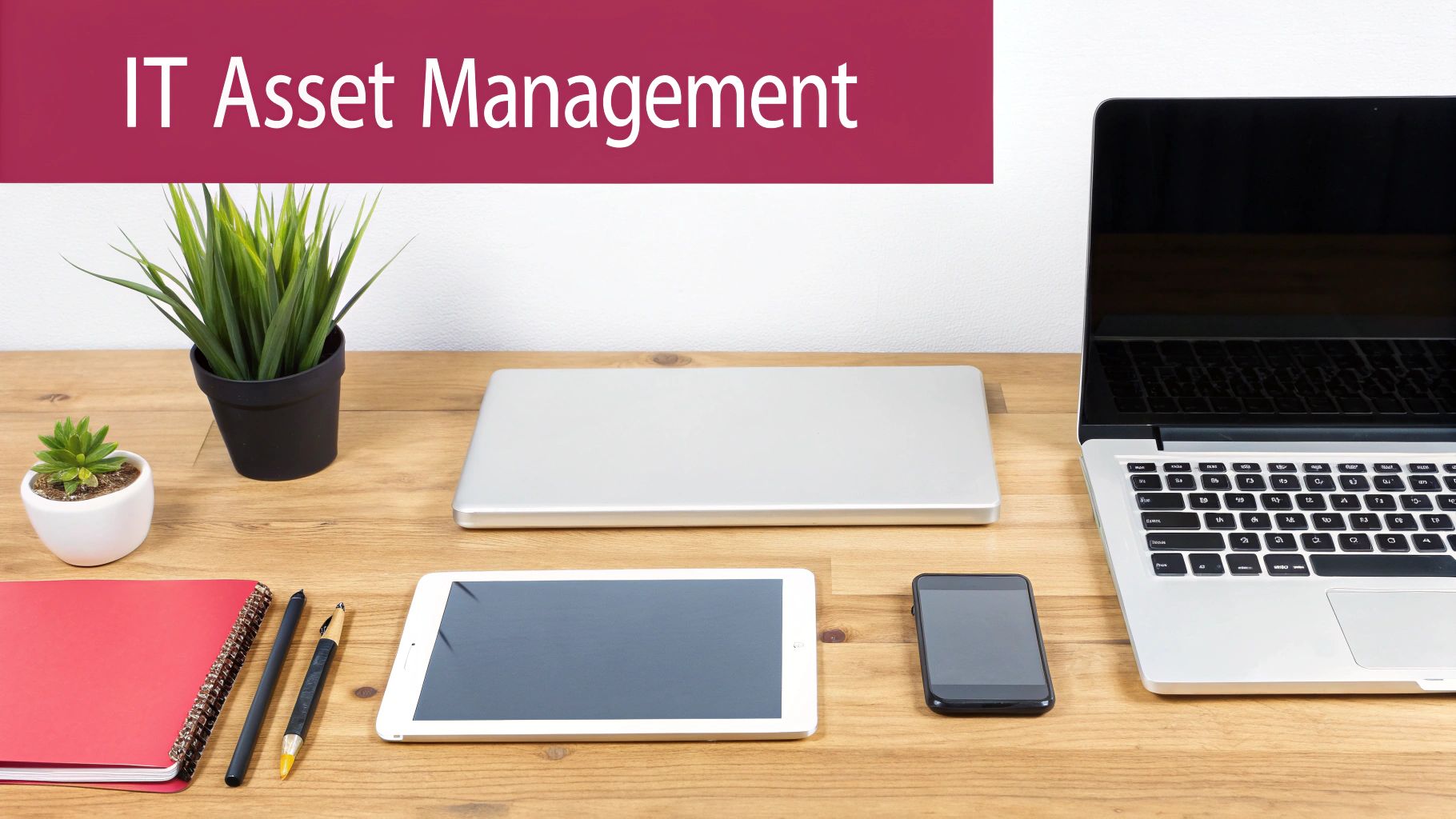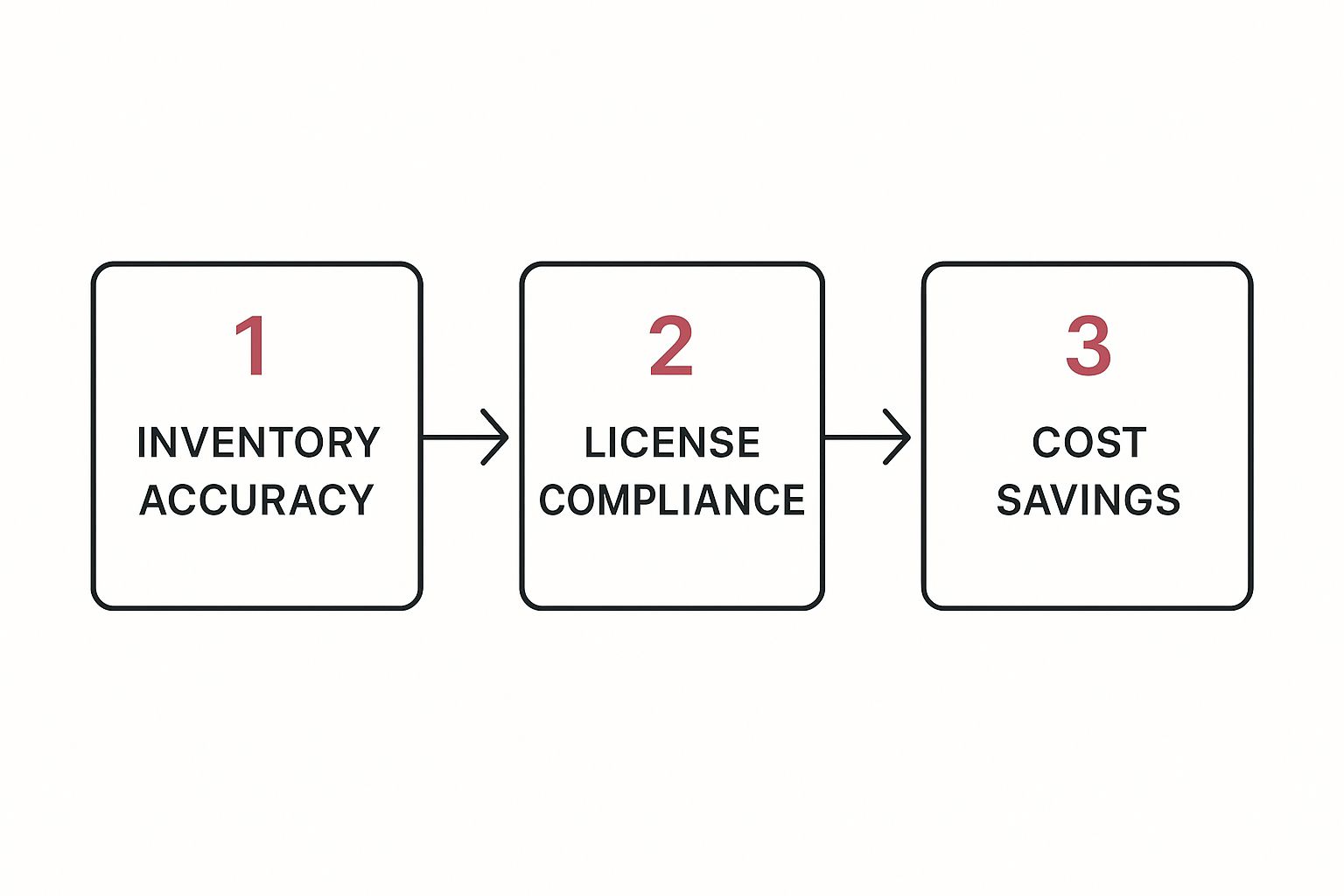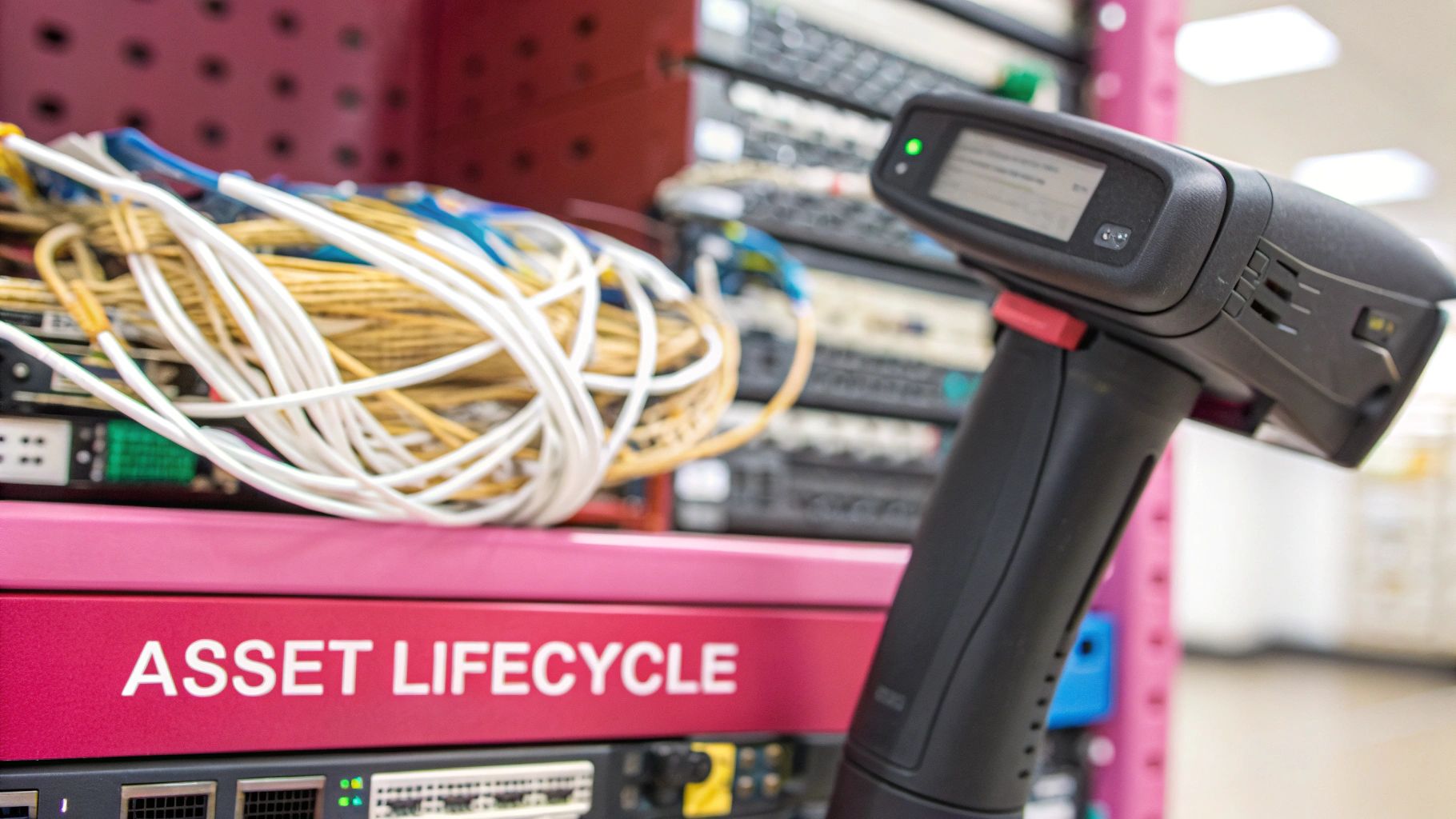What Is IT Asset Management? Your Guide to Business Success
IT Asset Management, or ITAM for short, is the complete business process for tracking and managing every single piece of technology your company owns, uses, and relies on. This isn't just about the obvious bits like laptops and software licences; it covers everything from cloud subscriptions to the mobile phones in your team's pockets.
What Is IT Asset Management in Simple Terms?

Think of it this way: imagine a professional services firm managing its client portfolio. To do it well, you'd need to know exactly which clients you have, who manages each account, what services they use, and when their contracts are due for renewal. ITAM is simply applying that same clear, business-minded logic to all of your technology.
This isn't just a job for the IT department, either. It’s a crucial business function that directly impacts your bottom line. When done right, ITAM gives you a full, detailed picture of your technology, empowering you to make smarter financial decisions, tighten up security, and improve how efficiently your whole business runs.
The Scope of IT Assets
So, what exactly counts as an "IT asset"? Basically, it’s any piece of company-owned technology or information that has value. This definition has grown over the years. It now covers not just physical hardware and software, but also intangible cloud services that are just as vital to modern operations.
Having a complete and accurate inventory is the foundational first step. A comprehensive view lets a business see its total technology spend and spot opportunities to save money. For instance, a small marketing agency in Dorset might discover it's paying for 20 licences for a design tool but only has 15 active users. Without a proper ITAM process, that wasted expense would almost certainly go unnoticed.
IT Asset Management transforms technology from a simple operational expense into a strategically managed portfolio. It shifts the focus from merely owning assets to optimising their value throughout their entire lifecycle.
Core Components of ITAM
To really get to grips with what IT Asset Management is, it helps to break down the different types of assets involved. Each category has its own unique lifecycle and management needs, from handling security updates for software to complying with disposal regulations for old hardware.
Software, in particular, has its own set of complexities. For a deeper dive, this resource is a great starting point: What Is Software Asset Management: A Guide.
The table below illustrates these core components with some practical examples you might find in a typical UK professional services firm.
Core Components of IT Asset Management (ITAM)
| Asset Category | Description | Practical Examples for a UK Professional Services Firm |
|---|---|---|
| Hardware Assets | The physical components of your IT infrastructure that your employees use daily. | Laptops for remote consultants, office desktop PCs for administrative staff, VoIP desk phones, company mobiles, and office printers. |
| Software Assets | All the applications and programs installed on your hardware, including licences and subscriptions. | Microsoft 365 subscriptions, Adobe Creative Cloud licences for the marketing team, accounting software (e.g., Xero, Sage), and antivirus programs. |
| Cloud Assets | Services and infrastructure hosted by third-party providers, accessed via the internet. | A private cloud environment on Amazon Web Services (AWS) for client data, a hosted 3CX VoIP phone system, and cloud backup solutions for disaster recovery. |
As you can see, the scope is broad, covering everything from the keyboard on a desk to the cloud server storing your critical business data. Properly managing all three is the key to a successful ITAM strategy.
The Five Stages of the IT Asset Lifecycle
Every piece of technology in your business, from a new consultant’s laptop to the firm’s accounting software, has a finite lifespan. Thinking about this journey—what we call the IT asset lifecycle—is the very core of IT asset management. It gives you a roadmap for handling technology from the moment it arrives to the day it leaves, helping you get the most value out of it while keeping risks in check.
The lifecycle breaks down into five key stages. Each one is a chance to exert control and find efficiencies. If you drop the ball at any point, you could face spiralling costs, glaring security holes, or some serious compliance headaches. For a professional services firm, staying on top of this process isn't just good practice; it's essential.
Stage 1: Procurement
The journey starts with Procurement. This is so much more than a simple shopping trip for new equipment. At this initial stage, you're strategically planning and acquiring assets that solve a genuine business need. For example, a Wiltshire-based accountancy firm wouldn't just grab any laptop off the shelf. They'd need to choose a model with the right processing power and specific security features to handle sensitive client financial data.
This stage involves:
- Needs Analysis: Pinpointing exactly what technology is required and why. For example, does a new junior consultant need a high-spec laptop or will a standard model suffice?
- Vendor Selection: Finding reliable suppliers who offer good value and solid support.
- Purchase Negotiation: Agreeing on the best possible terms and pricing.
Getting procurement right stops you from overspending and ensures new assets are fit for purpose from the get-go.
Stage 2: Deployment
Once you've acquired an asset, it’s time for Deployment. This is the hands-on part where the technology is configured, installed, and given to the person who will use it. Crucially, this is also the moment the asset must be officially entered into your IT asset register. Imagine a new server arriving for a legal firm in Hampshire. It would need to be installed in the server room, have its security hardened, and have all its details—like the serial number, location, and configuration—recorded before it ever goes live.
A smooth deployment means the asset is ready for productive use and, just as importantly, is visible to your management systems from day one.
A structured ITAM process turns a series of separate business activities into one cohesive strategy. By managing each lifecycle stage, you link inventory accuracy directly to better compliance and tangible cost savings.
The infographic below shows how managing this flow translates into real business benefits.

This process highlights that a precise inventory is the bedrock for staying compliant with software licences and, ultimately, cutting down on unnecessary spending.
Stage 3: Utilisation and Maintenance
Now we enter the longest phase of the asset’s life: Utilisation and Maintenance. Throughout its working life, every asset needs ongoing attention to keep it secure, efficient, and dependable. This covers everything from routine software updates and security patches to hardware repairs and helpdesk support.
Think about your firm's CRM software. It needs timely updates to guard against new security threats and to keep working smoothly for your client relationship team. A proactive approach here prevents the major disruption that comes with unexpected system failures.
Stage 4: Support
As assets age, the Support stage becomes more critical. This is where you manage warranties, renew support contracts, and handle repairs or upgrades. It’s about ensuring that when things go wrong, you have a clear plan to fix them quickly.
For example, a project management firm might have a support contract for its critical planning software. Without tracking the renewal date, the contract could lapse, leaving them without expert help during a system outage on a major client project. Tracking support status ensures you’re never caught off guard.
Stage 5: Retirement
Eventually, every asset reaches the end of its road. The Retirement stage is where you formally decommission the technology. This isn’t as simple as shoving an old computer in a storage cupboard. The final step involves responsible IT asset disposal, a process that helps reduce e-waste and, critically, protects sensitive data.
Proper disposal means securely wiping all data to prevent a breach and recycling the hardware in an environmentally friendly way. For a law firm, this would involve using certified data destruction methods to erase all client-sensitive information from a retiring partner's laptop, thereby protecting the firm from legal trouble and upholding its professional duties.
Why ITAM Is a Game-Changer for UK Professional Services

Let’s be honest: IT Asset Management (ITAM) might sound like just another item on a long to-do list. But in reality, it's much more than a simple inventory count. When done right, ITAM becomes a powerful strategic tool for any UK professional services firm. It's about taking what looks like a necessary expense and turning it into a genuine competitive edge.
The real magic happens when you start connecting your technology directly to your business goals. Think better financial planning, stronger cybersecurity, and a much easier path to meeting strict regulations like GDPR. These aren't just IT headaches; they're fundamental pillars of a successful business.
Financial Optimisation and Cost Control
One of the first things you'll notice with a solid ITAM programme is the impact on your bottom line. Having a precise, up-to-date record of every piece of hardware, software licence, and cloud subscription lets you spot and eliminate waste. We're talking about 'ghost assets'—equipment that's been lost, stolen, or is simply sitting in a cupboard but still appears on your books—and software licences you're paying for but nobody is using.
For businesses that rely on cloud services, ITAM is the key to unlocking effective SaaS cost optimization strategies. For example, a consultancy might realise it's paying for premium project management software seats for team members who only need view-only access. Adjusting these subscriptions can lead to significant savings. This is becoming more critical as the UK asset management market itself grows. Valued at roughly USD 12.30 billion this year, it's projected to hit USD 22.50 billion by 2033. Managing the technology that underpins this growth is no small task.
By knowing exactly what you own, what it costs, and who uses it, you can make informed decisions that cut waste and redirect funds to areas that actively support business growth. ITAM transforms your technology from a cost centre into a strategically managed investment.
Enhanced Security and Risk Reduction
In a world where cyber threats are always evolving, knowing exactly what’s connected to your network is your first line of defence. ITAM gives you the complete visibility needed to make sure every device is secure, all software is patched, and you have no unauthorised apps—known as 'shadow IT'—creating easy entry points for attackers.
Imagine you get a notification for a software audit from a vendor like Adobe or Microsoft. Without detailed licence records, this can be a mad scramble, potentially ending in hefty non-compliance fines. But with a robust ITAM system, you have all the proof you need at your fingertips. A stressful audit becomes a simple, routine check-up. This kind of proactive oversight is one of the 7 key managed IT services benefits, which we explore in another article.
Streamlined Compliance and Decision-Making
Finally, good ITAM provides the reliable data you need for smarter strategic planning and easier compliance. For regulations like GDPR, you need to know precisely where personal data is stored and processed. ITAM gives you that map, showing which servers hold client data or which laptops have access to it.
This level of detailed oversight allows your business to move with more confidence, knowing your technology foundation is solid, secure, and fully accounted for. It's the bedrock for making better, faster decisions.
How to Implement ITAM in Your Business
Getting started with IT Asset Management, or ITAM, doesn't need to be a colossal undertaking. You don't need a huge budget or a brand-new department. For most professional services firms, the trick is to start small with a clear, practical plan that can grow alongside your business. Think of it as creating a simple blueprint, turning a seemingly complex job into a manageable project.
The first, and most crucial, step is to conduct an asset audit. This is your ground zero. You need to map out every single piece of technology your company owns and uses, from the obvious to the easily forgotten. Your goal is to build your first asset register, which can be as straightforward as a well-organised spreadsheet to begin with.
For each item, you'll want to capture the essentials. With hardware like laptops and monitors, jot down the serial number, who it's assigned to, when it was bought, and its warranty details. For software, note down the product name, licence key, renewal date, and how much it costs you each year. This simple act of documentation brings immediate clarity to what you actually have and, just as importantly, what you're spending.
Choosing the Right Tools and Policies
Once you have that initial inventory nailed down, it's time to pick a tool that makes sense for your business right now. A "smart spreadsheet" is a fantastic starting point, but as your company expands and your needs get more sophisticated, you’ll probably want to look at dedicated ITAM software. The right tool automates tracking and reporting, saving you countless hours.
Alongside your chosen tool, you need to establish clear policies for managing your assets. These aren't meant to be bureaucratic hurdles; they're simple, common-sense guidelines that everyone can understand and follow.
- Procurement Policy: A clear process for how new tech is requested, approved, and purchased.
- Deployment Policy: A simple checklist for setting up new gear and—critically—adding it to your asset register straight away.
- Retirement Policy: A secure and responsible procedure for wiping data and disposing of old hardware.
Defining these steps is fundamental to effective IT change management, as it ensures every tweak to your IT setup is tracked and controlled. You can dive deeper into this with our guide on IT change management processes.
Assigning Ownership and Driving Growth
The final piece of the puzzle is accountability. Someone needs to own this. Nominate a person or a small team to be responsible for keeping the asset register accurate and up-to-date. Without clear ownership, even the best systems fall into disrepair. For instance, a London-based consultancy might give its office manager responsibility for all physical hardware, while a finance assistant looks after software subscriptions like Microsoft 365 and Adobe Creative Cloud.
Implementing ITAM is less about the technology itself and more about the process. By creating a simple system and assigning clear responsibility, you build a solid foundation for financial control and operational security.
This disciplined approach to managing technology isn't new; it mirrors practices seen in other high-value industries. Take the UK's wealth management market—a field that, in principle, shares a lot with ITAM. It's valued at over £2 trillion, and that immense value is built on meticulous management and strategic planning. You can discover more insights about recent trends in this market on lincolninternational.com. By applying that same level of discipline to your IT assets, you give your business the power to build a robust ITAM foundation without getting bogged down.
Common ITAM Pitfalls And How To Avoid Them

Even the most thorough IT Asset Management (ITAM) programme can hit unexpected snags. Spotting the usual missteps early means you’ll dodge common traps and see real benefits sooner.
Too often, organisations treat asset management as an afterthought, rather than with the same rigour as their core financial controls. Consider the UK fund management sector: it handles nearly £1.5 trillion in assets with painstaking oversight. Borrow just a fraction of that discipline for your technology, and you’ll avoid costly oversights. For more on that industry’s precision, see the UK fund management industry on statista.com.
Below are three frequent pitfalls and practical tactics to tackle each one head on.
The Pitfall Of Inconsistent Tracking
Missed devices and outdated records quickly derail your asset register, creating ghost assets that cloud budgeting and risk assessments. For example, a laptop assigned to an employee who left the firm six months ago might still be on your books, representing a security risk and an unaccounted-for asset.
Key Steps To Keep Records Spot-On
- Introduce a strict check-in/check-out routine: no device moves in or out without a logged entry.
- Assign clear ownership: every asset must have a named custodian.
- Automate reminders: schedule alerts for quarterly audits to catch discrepancies.
Overlooking SaaS And Cloud Subscriptions
Physical hardware often gets all the attention, yet unused licences for tools like Microsoft 365 or Slack can quietly erode your budget. A typical professional services firm might have dozens of subscriptions, and it's easy to lose track.
How To Rein In Subscription Sprawl
- Treat every licence as a line item in your register.
- Appoint department heads to review usage regularly (ideally, every three months).
- Terminate idle accounts promptly to stop wastage.
“True asset management is not a single project but an ongoing rhythm of tracking, reviewing and refining.”
Insecure Asset Disposal
Dumping old laptops or drives without wiping them is an open invitation for data breaches—and hefty legal headaches.
A Secure Retirement Policy Should Include
- Data sanitisation: follow government-approved wipe standards before disposal.
- Formal sign-off: record who approved the retirement and when.
- Certified recyclers: partner with vendors that provide disposal certificates.
For deeper guidance on crafting robust security policies, check out the importance of IT security policies and procedures.
Your IT Asset Management Questions Answered
When business owners and managers first dip their toes into the world of IT asset management, a few common questions always seem to pop up. Getting straight answers to these queries is often the key to moving forward with confidence.
Here, we'll tackle those frequently asked questions head-on, providing clear, practical insights specifically for professional services firms in the UK.
Is IT Asset Management Only For Large Corporations?
Not at all. While big corporations certainly need complex ITAM systems, the underlying principles are arguably even more vital for small and medium-sized enterprises (SMEs). Think about it: for a smaller business, the financial sting of a single lost laptop or a surprise software audit failure hits much, much harder. A small consultancy might find that the cost of failing a single software audit could wipe out a whole quarter's profit.
The goal isn't to replicate a corporate-level system from day one. It's about starting with a simple, organised approach—even a detailed spreadsheet is a fantastic start. This builds the right habits early, giving you the visibility to control costs, secure your data, and make smarter tech investments as your business grows.
What's The Difference Between An IT Asset Register And ITAM?
This is a really important distinction. An IT asset register is simply the list—it’s the "what" and "where" of your technology. It's a foundational document, like a spreadsheet, that tells you what laptops you have and who's using them. It’s your inventory.
IT Asset Management (ITAM), on the other hand, is the entire strategic process you build around that list. ITAM is the collection of policies, procedures, and day-to-day actions you take to manage an asset through its entire lifecycle, from the moment you buy it to the day you securely dispose of it.
Your register is the inventory; ITAM is the management strategy that turns that inventory into real business value through cost savings, better security, and smarter decisions.
In short, you can’t have effective ITAM without an asset register, but having just the register isn't ITAM.
How Can We Start ITAM On A Tiny Budget?
Starting with limited funds is not only possible, it's the most sensible way to begin. The secret is to focus on establishing a solid process, not on buying fancy software.
Kick things off with a manual audit. Walk around, talk to your team, and create your first asset register in a spreadsheet. List all your hardware (laptops, monitors, phones) and every piece of software (licences, subscriptions).
For every item, make sure you track these basics:
- Asset ID: A unique code you create for it.
- Asset Type: Is it a laptop or a software licence?
- Assigned User: Who is responsible for it?
- Purchase Date & Cost: Essential for your accounts.
- Warranty/Renewal Date: Crucial for managing subscriptions and support.
The most critical step is creating a simple but mandatory process for keeping this document up-to-date. Every time a new device is bought, an employee leaves, or a laptop is retired, the register must be updated. When you're just starting, consistency is far more valuable than costly software.
How Exactly Does ITAM Improve Our Cybersecurity?
ITAM is a cornerstone of any good cybersecurity posture. When you know exactly what hardware and software are connected to your network, you can ensure every single device is protected with up-to-date antivirus and that all software is patched against the latest threats.
It’s your first line of defence against 'shadow IT'—that unauthorised software employees might install, which can create unmonitored backdoors for cyber attacks. Most importantly, a proper ITAM process includes secure disposal. This ensures that when a device reaches the end of its life, its hard drive is wiped clean of all sensitive company data before it's recycled, preventing a potentially disastrous data breach from old equipment.
Managing your IT assets properly is fundamental to financial control, robust cybersecurity, and operational resilience. For over 30 years, SES Computers has provided expert managed IT support to businesses across Dorset, Hampshire, Wiltshire, and Somerset, helping them build secure and efficient technology foundations. If you’re ready to gain full control over your IT environment, get in touch with our team today.